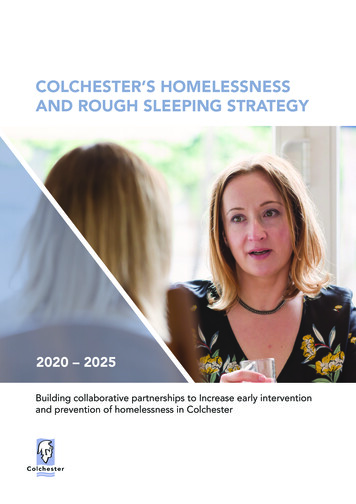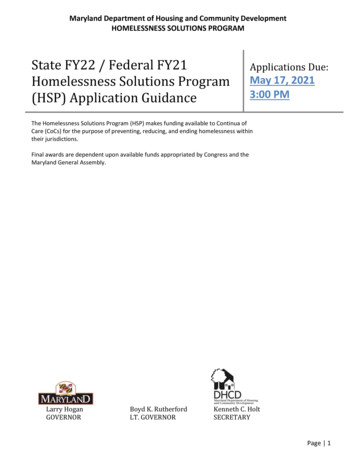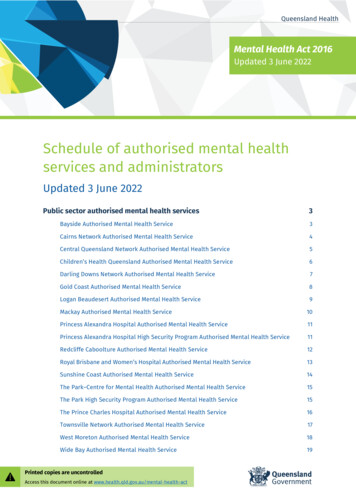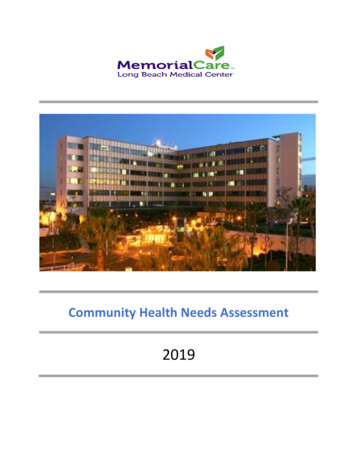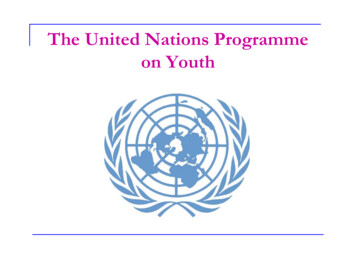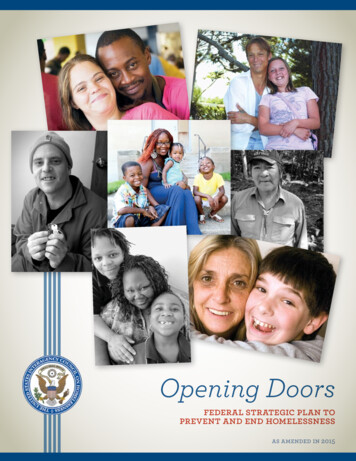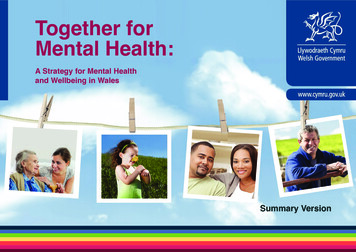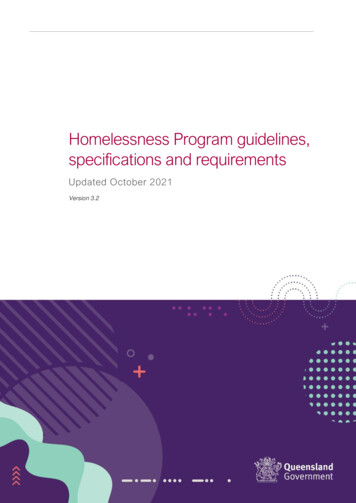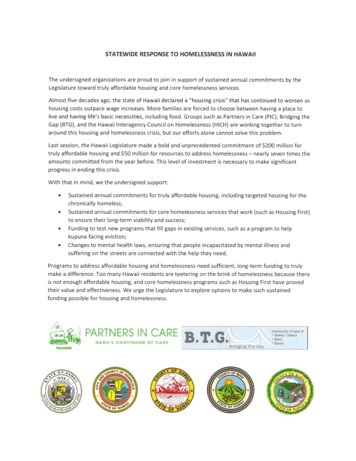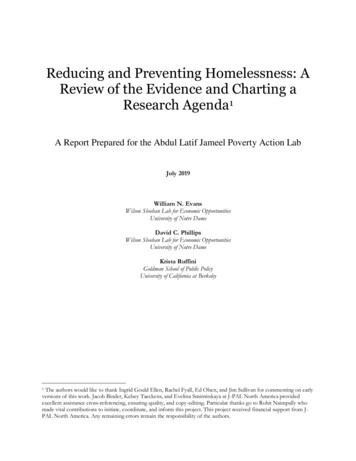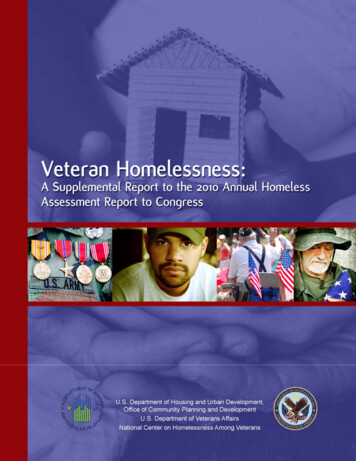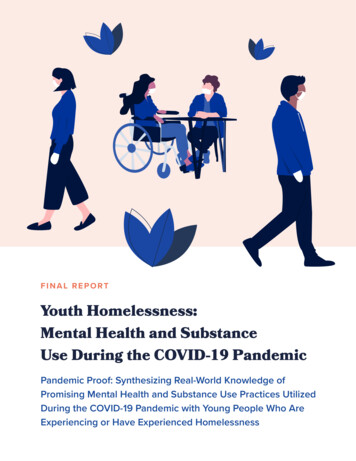
Transcription
FINAL REPORTYouth Homelessness:Mental Health and SubstanceUse During the COVID-19 PandemicPandemic Proof: Synthesizing Real-World Knowledge ofPromising Mental Health and Substance Use Practices UtilizedDuring the COVID-19 Pandemic with Young People Who AreExperiencing or Have Experienced Homelessness
Pandemic Proof:Pandemic Proof: Synthesizing Real-World Knowledge of PromisingMental Health and Substance Use Practices Utilized During the COVID-19Pandemic with Young People Who Are Experiencing or Have ExperiencedHomelessnessNominated Principal Investigator: Dr. Naomi ThulienCo-Prinicipal Investigator: Dr. Amanda NobleAuthor Affiliations:Thulien, N.S.,1,2,3 Noble, A.,4,5 Akdikmen, A.,1 Ali, D.,5 Coplan, I.,5 Daley, M.,6 French, D.,7Hwang, S.W.,2,8,9 Kidd, S.,10,11 & Roglich, J.11. School of Nursing, McMaster University, Hamilton, ON2. MAP Centre for Urban Health Solutions, Li Ka Shing Knowledge Institute ofSt. Michael's Hospital, Toronto, ON3. Centre for Critical Qualitative Health Research, University of Toronto, Toronto,ON4. Factor-Inwentash Faculty of Social Work, University of Toronto, Toronto, ON5. Covenant House Toronto, Toronto, ON6. Lived Experience Lab, Toronto, ON7. A Way Home Canada, Toronto, ON8. Division of General Internal Medicine, Department of Medicine, University ofToronto, Toronto, ON9. Dalla Lana School of Public Health, University of Toronto, Toronto, ON10. Department of Psychiatry, University of Toronto, Toronto, ON11. Psychology Division, Centre for Addiction and Mental Health, Toronto, ONHow to Cite This Document:Thulien, N.S., Noble, A., Akdikmen, A., Ali, D., Coplan, I., Daley, M., French, D., Hwang,S.W., Kidd, S., & Roglich, J. (2020). Pandemic Proof: Synthesizing Real-World Knowledgeof Promising Mental Health and Substance Use Practices Utilized During the COVID19 Pandemic with Young People Who Are Experiencing or Have ExperiencedHomelessness. Toronto: Canadian Observatory on Homelessness Press.YOUTH HOMELESSNESS: MENTAL HEALTH AND SUBSTANCE USE DURING THE COVID-19 PANDEMIC2
ISBN: 9781550146776 2020 Canadian Observatory on Homelessness PressThis research paper is protected under a Creative Commons license that allows you toshare, copy, distribute, and transmit the work for non-commercial purposes, providedyou attribute it to the original source.Acknowledgements:We respectfully acknowledge that the land on which we developed this report is intraditional First Nation, Inuit, and Métis territory. Specifically, this report was developedin Toronto, on the traditional territory of many nations including the Mississaugas ofthe Credit, the Anishnabeg, the Chippewa, the Haudenosaunee, the Seneca, andthe Huron-Wendat, and in Hamilton, on the traditional territory of the Erie, Neutral,Huron-Wendat, Haudenosaunee, and Mississaugas. We stand in solidarity withIndigenous youth who are overrepresented in the population of young people who areexperiencing or have experienced homelessness.We extend our deepest gratitude to the young people and providers who took the timeto provide their expertise for this report.Also supporting this research are the following collaborators: A Way Home Canada,Covenant House Toronto, and Lived Experience Lab.This work was supported by the Canadian Institutes of Health Research KnowledgeSynthesis Grant: COVID-19 Rapid Research Funding Opportunity in Mental Health andSubstance Use (funding reference number: CMS 171713).Design by Chris Durand, Canadian Observatory on Homelessness (Hub Solutions).Hub Solutions is a social enterprise embedded within the Canadian Observatory onHomelessness (COH). Income generated from Hub Solutions fee-for-service work isreinvested into the COH to support research, innovation, policy recommendations andknowledge mobilization. Learn more: www.hubsolutions.caYOUTH HOMELESSNESS: MENTAL HEALTH AND SUBSTANCE USE DURING THE COVID-19 PANDEMIC3
Table of ContentsExecutive Summary Background and Overview 6101. Background and Overview 112. Research Methodology 13Survey Data 151. Demographics: Survey Respondents 162. P andemic Impacts on Mental Health and Substance Use Patterns 173. P andemic Impact on Agency/Organization 234. Practice Adaptations 245. Promising and Transformative Approaches 28Provider Focus Groups 361. P andemic Impacts on Mental Health and Substance Use Patterns:A “snowstorm” of inequities 382. P ractice Adaptations: Reaching out 413. P romising and Transformative Approaches: The magic wand question 45Youth Focus Group 471. Impacts on Mental Health and Substance Use Patterns:“I like things in person” 492. P ractice Adaptations: “There’s not a lot of resources” 503. P romising and Transformative Approaches:“It gets a little sad and a little exhausting” 53YOUTH HOMELESSNESS: MENTAL HEALTH AND SUBSTANCE USE DURING THE COVID-19 PANDEMIC4
Discussion 561. Pandemic Impacts on Mental Health and Substance Use Patterns 592. Practice Adaptations 643. P romising and Transformative Approaches 684. Limitations 77Recommendations and Conclusion 78Conclusion 81References 82YOUTH HOMELESSNESS: MENTAL HEALTH AND SUBSTANCE USE DURING THE COVID-19 PANDEMIC5
Executive Summary“When this pandemic started a lot of folks were talking about it being thegreat equalizer – we are all in the same situation. We very quickly realizedthis was not the case.” front-liner provider (focus group participant)The COVID-19 pandemic is highlighting societal inequities in an unprecedented manner.Young people who are experiencing or have experienced homelessness are disproportionately impacted by the negative socioeconomic consequences of the pandemic. Thepandemic has also made visible the precarious existence in which these young peoplelive.The aim of this knowledge synthesis was todeliver real-world evidence on promising mentalhealth and substance use practices utilized byfront-line providers working during the COVID-19pandemic with young people who were experiencing or had experienced homelessness.However, the evidence we uncovered over thepast five months has been less about downstreamindividual-level interventions and more about theneed for upstream structural interventions.Key Messages:We must pay special consideration to the mental health and substance use needsof young people with current and past experiences of homelessness, who are morelikely than the general population to have pre-existing mental health challenges,struggles with financial hardship, and employment uncertainty.Providers must be careful not to inadvertently perpetuate access inequities –already common in this population – by pivoting to phone/virtual care withouthaving a concurrent plan around addressing resource-related barriers to access.YOUTH HOMELESSNESS: MENTAL HEALTH AND SUBSTANCE USE DURING THE COVID-19 PANDEMIC6
While it intuitively makes sense to divert young people from the shelter system –especially during a pandemic – we must ensure these young people have the socialand economic supports needed not just to survive, but to thrive in the mainstream.During this pandemic, there is a pressing need to understand what individual-level practice adaptations hold promise to meet the mental health and substance use needs ofyoung people who are experiencing or have experienced homelessness; however, it isessential that we situate this need and our response within the broader societal contextin which youth exist.The way we frame a health issue is important because it will influence our understandingof the solutions. For example, if the problem of worsening mental health and substanceuse is caused by/connected to structural determinants of health such as racism, insufficient housing, precarious employment, limited social connections, and poverty, and notindividual “vulnerability” (a term that denotes weakness and is used all too often whenreferring to youth experiencing homelessness), then it is logical that the proposed solutions should encompass structural interventions.“My greatest challenge has been not being ableto access supports in person. I like things inperson – just having that routine of going. Beingoff work and school, and not having a lot to do, Ikinda declined in my mental health. I becamevery isolated and alone and not really going out asmuch.” youth (focus group participant)“There’s a lot of youth out there who have issuesand anxiety and everything. I’m one of them. It’shard to know that, in this pandemic, there’s not alot of resources.” youth (focus group participant)This report contains survey data from 188 front-line providers across Canada and issupplemented by three focus groups – two with providers and one with young peoplewho have experienced homelessness. We have endeavored to situate these findingsYOUTH HOMELESSNESS: MENTAL HEALTH AND SUBSTANCE USE DURING THE COVID-19 PANDEMIC7
within the rapidly evolving literature on pandemic-related impacts on mental health andsubstance use. Below are our recommendations for practice, research, and policy:Practice Increase (not decrease) outreach and do so ina proactive way (reach out to youth not seekingservices) Increase staffing levels to facilitate enhancedengagement (consider staff burnout) Consider a blended model of phone/virtual support(ensure adequate staff training), in-person visits, andholistic outreach (phone/virtual supports will not beequitable for all) Consider implementing wellness checks (phone orin-person) Constantly evaluate the effectiveness of practiceadaptations – there is no one size fits all approach Proactively alleviate the amount of systemnavigation work required of young people(consider active collaboration with other agencies/organizations)Research Pilot promising phone/virtual supports (e.g., cognitive behavioral therapyinterventions) that have been tested with young people who have notexperienced homelessness (rigorous testing – ideally with a control group forcomparison – is crucial) Incorporate perspectives of young people with current and past experiencesof homelessness into all phases of the research process (crucial for anyresearch involving young people who are experiencing or have experiencedhomelessness) Assess how intervention outcomes vary by subpopulations (e.g., 2SLGBTQ ,Indigenous, and racialized youth)YOUTH HOMELESSNESS: MENTAL HEALTH AND SUBSTANCE USE DURING THE COVID-19 PANDEMIC8
Incorporate and test the integration of virtual supports into promising evidencebased complex wraparound interventions for youth exiting homelessness (e.g.,Kidd et al., 2019; Kidd et al., 2020) Rigorously study promising interventions related to system navigation (e.g.,connecting youth with an advocate/mentor), early intervention (e.g, connectingyouth to family/natural supports), and housing stabilization (e.g., rent subsidiesand cash transfers) – look at longitudinal outcomes beyond housing stability, suchas socioeconomic inclusionPolicy Consider the intersecting nature of social determinants of health (e.g., race, class,gender, income, and education) when putting forward solutions to address youthhomelessness Augment investments in agencies/organizations serving young peopleexperiencing homelessness so they can prioritize an equity-informed approach(e.g., enhance in-person outreach to the most marginalized and free/affordabledevices to access virtual/phone supports) Consider the potential cost-effectiveness of rent subsidies and cash transfers(collaboration with researchers would be helpful here) Invest in long-term outcomes beyond housing stability (e.g., equitablesocioeconomic inclusion)“One thing I’ve noticed is their source of community, thatsense of belonging, it has been jeopardized. Not onlybecause things are closed, but because they now haveto adapt, or navigate, rebuilding relationships throughdifferent avenues.” front-line provider (focus group)The COVID-19 pandemic has exposed and created asnowstorm of intersecting inequities that providers andyoung people are struggling to navigate. It also presentsa unique opportunity to reimagine how we serve youngpeople who are experiencing or have experiencedhomelessness. We trust this report makes a modestcontribution to the emerging literature on this topic.YOUTH HOMELESSNESS: MENTAL HEALTH AND SUBSTANCE USE DURING THE COVID-19 PANDEMIC9
Section 1Backgroundand Overview
Background and Overview1. Background and OverviewAn estimated 35,000-40,000 Canadian youth (aged 13 – 24 years) experience homelessness at some point during the year and at least 6,000 on any given night (Gaetz et al.,2016). The overwhelming majority have experienced some form of trauma and their challenges related to mental health and substance use have been documented for decades(Auerswald et al., 2019; Hwang, 2000; Karabanow, 2008; Kidd et al., 2017; Kulik et al., 2011;Roy et al., 2010; Wood et al., 2006). A recent pan-Canadian survey of 1,103 youth accessing homelessness services found that 42% had attempted suicide at least once and 84%reported high rates of psychological distress (Gaetz et al., 2016; Kidd et al., 2017).Struggles with mental health and substance use are not unique to young people currentlyexperiencing homelessness; rather, these challenges persist – and sometimes getworse – for young people who have experienced homelessness in the past. The limitedlongitudinal research on young people who have transitioned out of homelessness paintsa disheartening picture of economic precarity and social exclusion (Kidd et al., 2016;Thulien et al., 2018). Over time, these young people can become mentally exhausted andovercome by a sense of hopelessness, placing them at high risk of returning to homelessness (Kidd et al., 2016; Thulien et al., 2018; Thulien et al., 2019). In fact, 76% of youngpeople in the aforementioned pan-Canadian survey reported at least two failed attemptsat exiting homelessness (Gaetz et al., 2016).Intervention-focused research with this population is emerging but quite limited (Altena etal., 2010; Coren et al., 2016; Hwang & Burns, 2014; Luchenski et al., 2017; Morton, Kugley etal., 2020; Wang et al., 2019). Thus, it is against this backdrop of social and structural inequities and limited guidance in peer-reviewed literature around “what works” to improveoutcomes related to mental health, substance use, and sustained exits out of homelessness, that the COVID-19 pandemic came on the scene – accelerating our need for anevidence-informed response.The overall goal of this project was to synthesize real-world knowledge on promisingmental health and substance use practices utilized during the COVID-19 pandemicby front-line providers serving young people who are experiencing or have experienced homelessness.YOUTH HOMELESSNESS: MENTAL HEALTH AND SUBSTANCE USE DURING THE COVID-19 PANDEMIC11
Background and OverviewObjective 1Examine how COVID-19 has impacted the mental health and substance use patternsof young people who are currently experiencing or have experienced homelessness.We did this by beginning with an electronic survey to examine our key domains of:1) pandemic impacts on mental health and substance use patterns; 2) practice adaptations; and 3) promising and transformative approaches.Objective 2Identify how front-line providers have adapted their practices because of the pandemicand provide a youth-informed perspective to these adaptations. We did this by conducting three targeted focus groups with providers and young people who had experiencedhomelessness.Objective 3Highlight promising and transformative approaches to service delivery – particularly thosewith post-pandemic promise – that warrant further investigation. We did this by drawing onthe real-world expertise of young people and providers, and by searching the literature.YOUTH HOMELESSNESS: MENTAL HEALTH AND SUBSTANCE USE DURING THE COVID-19 PANDEMIC12
Background and Overview2. Research MethodologyThis project was informed by Community-Based Participatory Action Research (CBPAR)methodology – an approach that challenges traditional assumptions of what constitutes“good” evidence, demands researcher humility, and stresses genuine and equitableacademic-community partnerships (Wallerstein et al., 2018). Conceptually, the synthesiswas scaffolded by Critical Social Theory (Strega, 2005), meaning we endeavoured toappropriately contextualize our findings and recommendations, taking into account theintersecting inequities (e.g., age, race, class, gender, and sexual orientation) that contribute to the complexity of addressing the mental health and substance use needs of youngpeople who are experiencing or have experienced homelessness.Typically, a knowledge synthesis consists of examining peer-reviewed literature on atopic, combining these findings to create new insights, and then sharing these insightswith relevant knowledge users and decision makers (Grimshaw, 2010). However, given ourcommitment to CBPAR methodology (e.g., challenging what constitutes good evidence),the sense of urgency from our front-line colleagues to obtain real-time knowledge of whatother providers were doing, and our prior understanding that intervention-based literatureon youth homelessness is quite limited, we decided to take a different approach.We began this synthesis in June 2020, amassing on-the-ground perspectives from ourfront-line colleagues who serve young people who are experiencing or have experiencedhomelessness. We published a preliminary report on June 24, 2020, using data from anelectronic survey, which was available to front-line providers across Canada from June 10,2020 – June 17, 2020. Over the past five months, we further refined this synthesis throughthe generation of more qualitative data (focus groups with providers and young people)and further exploration of the peer-reviewed literature. This was an iterative process;findings from our electronic survey influenced the direction of our literature review andfocus group questions, and the focus group findings influenced subsequent reviews ofthe literature.MethodsThis study employed a convergent mixed methods design, meaning quantitative data(electronic survey) and qualitative data (electronic survey and focus group interviews)were collected at roughly the same time and the findings combined (Creswell & PlanoClark, 2018). We believe this methodology helped facilitate a more comprehensive,nuanced understanding of the data (Creswell & Plano Clark, 2018).YOUTH HOMELESSNESS: MENTAL HEALTH AND SUBSTANCE USE DURING THE COVID-19 PANDEMIC13
Background and OverviewThe 26-item electronic survey focused on three key domains: 1) pandemic impacts onmental and substance use patterns; 2) practice adaptations; and 3) promising and transformative approaches. The June 2020 survey was distributed through e-mail and socialmedia (e.g., Twitter) and open to all front-line providers in Canada serving youth (aged 16 –24 years) who had experienced or were experiencing homelessness. Then, we conductedthree focus groups – two with front-line providers (July 30, 2020 and August 6, 2020)and one with young people who had experienced homelessness (September 10, 2020)– via Zoom. Focus group questions were developed after analyzing the survey data, andfocused on our three key domains of interest. The provider focus groups were led byNaomi Thulien and the youth focus group was led by Mardi Daley and Naomi. Each focusgroup lasted one hour. Ethical approval was received by the Hamilton Integrated ResearchEthics Board.Quantitative survey data was analyzed by Amanda Noble and Isaac Coplan usingfrequency analysis. The qualitative survey data (free text responses) were independentlycoded (“tagging important pieces of data”) by Naomi and Mardi. The audio recorded focusgroups were transcribed and coded independently by Julia Roglich, Danielle Ali, andMardi. During the qualitative data (from the survey and focus groups) analysis and interpretation phase, the qualitative team members met with Naomi to discuss the codes, groupthe codes into conceptual categories, and merge the categories into themes (Creswell &Plano Clark, 2018). Throughout this process, we endeavoured to integrate the quantitativeand qualitative findings so we would expand our understanding of the emerging insights(Creswell & Plano Clark, 2018).In keeping with the critical social theoretical scaffolding of this study, our broader studyteam discussed what the data illuminated about intersecting structural-level inequitiesfaced by young people who are experiencing or have experienced homelessness. Thevaried experiences of our team members as front-line clinicians, researchers, public policyinfluencers, and having lived experience of homelessness, mental health challenges, andsubstance use, allowed us to provide a more contextualized, nuanced interpretation ofthe data. For example, our research colleagues with lived expertise were able to sharewhether the findings “rang true” from their own experiences with accessing mental healthand substance use supports.YOUTH HOMELESSNESS: MENTAL HEALTH AND SUBSTANCE USE DURING THE COVID-19 PANDEMIC14
Section 2Survey Data
Survey Data1. Demographics: Survey RespondentsSurvey respondents included 188 service providers from 36 cities/towns, across nine provinces/territories in Canada. All providers worked withyoung people aged 16-24 years who were experiencing or had experienced homelessness.Providers represented 65 organizations, withthe majority (80%) located in Ontario. The largestgroup of responses (62%) came from those working in emergency shelters and the second largestgroup of responses (31%) came from those working in a variety of settings ranging from housingprograms to prisons.62%of participating providersworked in a shelter settingProvider linicRespondent Roles4% 1%14%38%16%28%Front-Line Youth WorkerSocial WorkerManagementFront-Line MedicalOtherFront-Line NursingYOUTH HOMELESSNESS: MENTAL HEALTH AND SUBSTANCE USE DURING THE COVID-19 PANDEMIC16
Survey Data2. Pandemic Impacts on Mental Health andSubstance Use PatternsA. Changes in Mental Health PatternsIncreasedRemainedthe SameDecreasedNot SureBoredom92% (143)3% (5)1% (1)4% (7)Feeling isolated/lonely91% (142)6% (9)1% (1)3% (4)Anxiety85% (133)10% (16)1% (1)4% (6)Depression75% (117)17% (27)1% (1)6% (10)Sleep disturbances67% (102)18% (28)2% (1)14% (21)Increase in acuity/symptomsrelated to pre-existing mentalhealth conditions67% (104)21% (32)1% (1)11% (17)Suicidal ideation36% (55)38% (58)1% (2)25% (38)Self-harm25% (39)46% (70)2% (3)27% (41)Suicide attempts15% (24)54% (83)2% (3)29% (44)Positive mood8% (13)28% (44)69% (107)8% (12)Significant increase/increase and significant decrease/decrease responses have been combinedProviders reported the pandemic has had a tremendous impact on themental health of the young people they serve.Over 90% reported that youth had experienced asignificant increase/increase in feelings of isolationand loneliness, and boredom. Additionally, providers reported that anxiety (85%) and depression (75%)had significantly increased/increased among theirclients. Just under 70% of providers noted increasesin sleep disturbances and acuity/symptoms relatedto pre-existing mental health concerns.91%reported a significantincrease/increase inisolation and lonelinessYOUTH HOMELESSNESS: MENTAL HEALTH AND SUBSTANCE USE DURING THE COVID-19 PANDEMIC17
Survey Data36%reported a significantincrease/increase insuicidal ideationMany providers reported significant increases/increases in the level of suicidal ideation (36%), incidences of self-harm (25%), and suicide attempts(15%) among young people since the pandemicbegan.Youth Seeking and Accessing Mental Health Supports50%reported significantly limited/limited decrease in seekingmental health supports80%reported significantly limited/limited decrease in accessingmental health supportsYOUTH HOMELESSNESS: MENTAL HEALTH AND SUBSTANCE USE DURING THE COVID-19 PANDEMIC18
Survey DataB. Where Are Youth Going for Mental Health Supports?The top three most common places providers reported youth were going to access mentalhealth services were: online supports (63%), hospitals (42%), and emergency shelters(36%). Only 20% of young people were thought to be accessing mental health supportsthrough a primary care orts*HospitalShelterPrimaryCare ClinicNot ts were able to select multiple options*Helplines, online chats, support groups, etc.63%reported youth wereaccessing mental healthsupports onlineYOUTH HOMELESSNESS: MENTAL HEALTH AND SUBSTANCE USE DURING THE COVID-19 PANDEMIC19
Survey DataC. Changes in Substance Use PatternsIncreasedRemainedthe SameDecreasedNot SureUse of substance69% (108)17% (27)4% (6)10% (15)Overdoses37% (57)23% (36)4% (6)35% (54)Access to harm reductionmaterials/medication12% (19)35% (54)28% (43)25% (38)Access to naloxone kits6% (10)45% (70)19% (30)29% (45)Access to safe supply orsubstitution3% (5)29% (45)26% (41)42% (65)Access to abstinence-basedservices, groups, or meetings3% (5)17% (27)46% (71)33% (51)Access to supervised injectionsites1% (2)22% (34)26% (40)51% (80)Significant increase/increase and significant decrease/decrease responses have been combinedThe majority of providers (69%) reported they observed a significant increase/increase insubstance use since the COVID-19 pandemic began. It is especially important to note thereported increase in overdoses within this population (37%).69% 37%reported a significantincrease/increase insubstance usereported a significantincrease/increase inoverdosesWhile substance use was believed to have increased, providers also reported a significant decrease/decrease in access to abstinence-based services (46%), harm reductionmaterials (28%), and substitution therapy (26%).It is interesting to note that a large number of respondents were unsure where youth wereaccessing harm reduction supports during the pandemic. For instance, 51% of providersreported being unsure of how the pandemic had impacted access to supervised injection sites.YOUTH HOMELESSNESS: MENTAL HEALTH AND SUBSTANCE USE DURING THE COVID-19 PANDEMIC20
Survey DataD. Disproportionate ImpactsSome providers noted that worrisome changes in mental health and substance usepatterns appeared more prevalent among youth from certain subgroups. In particular,they reported 2SLGBTQ (two-spirit, lesbian, gay, bisexual, transgender, and queer), Indigenous, and racialized youth seemed especially impacted. Moreover, providers notedthat these additional challenges were increasing the complexity of their provider-clientinteractions.“Individuals who identify within oppressed groups face increased barriersfor accessing and having resources to for support when they hold anotheroppressive identify as a substance user. It's an added layer of stress andbarriers.”1. OPPRESSED IDENTITIESSeveral providers spoke of the challengesfaced by 2SLGBTQ youth who were havingto spend more time with non-affirming familymembers because they had to move backhome for financial reasons and/or limitedaccess to supportive friends and spaces.“Many refugees have seen first-hand whatcan happen when an illness sweepsthrough a community. This has createdgreater fear than the average person,especially when the young person is inCanada without a parent.”“Certainly trans and gender diverse youthhave discussed the complications ofnavigating unsafe home environments andhaving to conceal their identities withoutreprieve of being outside/with friends/within other affirming/supportive spaces.”Refugee and Indigenous youth were alsoreported to be feeling especially marginalized – disconnected from familiar supports(e.g., specialized programming) and culturalexperiences (e.g., sweat lodges), exacerbatingfeelings of loneliness.YOUTH HOMELESSNESS: MENTAL HEALTH AND SUBSTANCE USE DURING THE COVID-19 PANDEMIC21
Survey Data2. TRAUMA TRIGGERSThe heightened awareness of anti-Black and anti-Indigenous racism following the deathsof individuals such as George Floyd, Regis Korchinski-Paquet, and Chantel Moore wasreported to be retraumatizing for many racialized and Indigenous young people. Moreover, this trauma was thought to be exacerbated by the fact that many youth had toprocess their thoughts and feelings alone.“Some Black and POC [people of colour] youth I see have been strugglingdue to George Floyd's death, social media images and stories of abuse,and ongoing police brutality [ ]1. With COVID-19 limiting access to safespaces, community supports, and ability to hang out with friends, theimpacts of racism during this time have amplified negative impacts onmood, anxiety and social connection/safety.”3. UNINTENDED CONSEQUENCES OF PUBLIC HEALTH POLICYSeveral providers commented on the challenges associated with following public healthguidelines and how these recommendations can unintentionally exacerbate strugglesrelated to mental health and substance use – particularly among 2SLGBTQ , racialized,and Indigenous youth.“Public safety measures adopted during the crisis replicated state actionstaken historically which caused and still do cause significant harm.”Providers noted the importance of young people in the aforementioned groups spendingtime in social circles where they feel a sense of belonging. Restrictions on movement (e.g.,freedom to come and go from transitional housing) had made those sorts of connectionsdifficult. Additionally, several providers reported young people had increased their use ofsubstances and were using alone. Importantly, providers noted that many young peopledid not have equitable access to information technology, making it challenging to accessthe mental health and substance use supports they need.“[ ]assumptions were made that everyone has easy access to the internetand technology for virtual care[ ]”1. [ ] denotes missin
1. School of Nursing, McMaster University, Hamilton, ON 2. MAP Centre for Urban Health Solutions, Li Ka Shing Knowledge Institute of St. Michael's Hospital, Toronto, ON 3. Centre for Critical Qualitative Health Research, University of Toronto, Toronto, ON 4. Factor-Inwentash Faculty of Social Work, University of Toronto, Toronto, ON 5.
